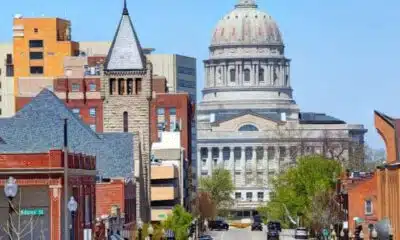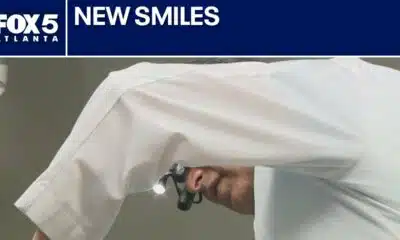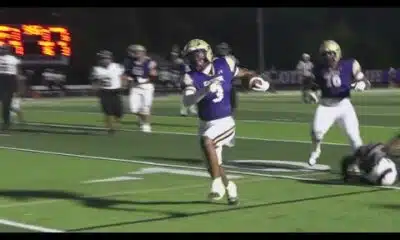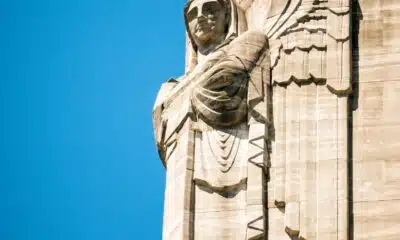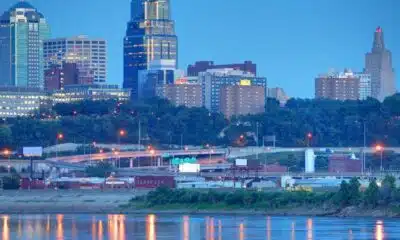News from the South - West Virginia News Feed
As feds resume student loan collections, states try to catch borrowers before they sink
by Robbie Sequeira, West Virginia Watch
June 6, 2025
Over the past few months, Celina Damian’s phone has been ringing off the hook with one bewildered, anxious question after another: “What kind of loan is this?” “Am I in default?” “Will the government really take my wages?”
“Sometimes they just don’t know where to start,” said Damian, California’s student loan servicing ombudsperson.
“I’m talking to borrowers from all ages, from new borrowers to — I have 80-, 90-year-old borrowers,” she said.
The federal government last month restarted collections on defaulted loans. State student loan ombudspersons such as Damian have become some of the only sources of contact for worried borrowers lost in a tangle of conflicting information at the federal level about their loan status and repayment options.
The U.S. Department of Education began collecting on defaulted student loans in May for the first time since the beginning of the COVID-19 pandemic in March 2020.
Federal student loans issued by the U.S. Department of Education come with fixed rates, set repayment plans and borrower protections. Private servicers handle billing, repayment-plan enrollments and defaults.
More than 5 million borrowers are in delinquency, and nearly 10 million — about 25% of the federal student loan portfolio — are at risk of default within months, according to data from the U.S. Department of Education.
States can’t cancel that debt, but they do register and oversee servicers operating in their states, run ombuds offices, tweak tax rules and offer outreach or limited grants — actions aimed at reducing defaults and the economic fallout.
When borrowers default, states will likely feel the economic impact. They might lose tax revenue as homebuying stalls. They could end up paying more for Medicaid and social services if borrowers need to rely on them. And students with loan debt may be reluctant to go into lower-paying public-sector work, leading to staffing shortages at state agencies.
A borrower is considered delinquent after missing a payment to the servicing companies that handle billing, repayment plan enrollments, and defaults.
Damian’s office, established under California’s Student Borrower Bill of Rights, began as a narrow statutory role but now serves as a hub for outreach, “Student Loan 101” workshops and escalated complaints to federal agencies.
Roughly 16 states plus the District of Columbia have followed suit, creating ombuds offices to guide borrowers through confusing paperwork and misinformation. Damian believes these ombuds offices should be in every state, as borrowers across the country will likely have similar questions and little help at the federal level.
“If you don’t have an ombudsperson or even just a person at the state level who can educate borrowers, that will make a difference,” Damian told Stateline. “These borrowers are trying to pay, but the system is broken. No other financial product works this way.”
Student loans became a key issue during last year’s election race, with President Joe Biden blocked by the U.S. Supreme Court in his effort to offer relief to 40 million Americans. In its waning days, his administration did forgive loans for some 150,000 borrowers under previous programs.
But President Donald Trump opposes most loan forgiveness programs, and in May, the U.S. Education Department issued a “Dear Colleague” letter to higher education institutions, reminding them of their legal obligations to help former students understand repayment responsibilities and access support.
These borrowers are trying to pay, but the system is broken. No other financial product works this way.
– Celina Damian, California student loan servicing ombudsperson
Some conservative economists say that federal loan forgiveness and financial aid hurt all students, offering colleges an incentive to raise tuition or lower their own institutional aid.
Winston Berkman-Breen, the legal director at the Student Borrower Protection Center, a nonprofit aimed at protecting borrowers and improving the repayment system, said that more than 2 million borrowers are stuck in a backlog of unprocessed applications for income-driven repayment (IDR) plans — calculated pay structures meant to keep payments affordable based on a borrower’s income.
Other borrowers have called federal agencies for help only to find that U.S. Education Department staff, including servicer-oversight teams, have been laid off as the Trump administration works toward dismantling the department entirely.
“There was an expectation to repay,” Berkman-Breen said. “But there was also an expectation that people would have access to affordable plans. That promise has broken down.”
States now have three primary tools to address student loan debt, Berkman-Breen said: enforcement actions to protect consumers, such as the 39-state lawsuit against servicer Navient; legal oversight by suing to uphold or challenge federal policy; and direct outreach to help public servants access Public Service Loan Forgiveness and similar programs.
Nineteen states now require registration for companies that service student loans, he said. And more than a dozen states align with federal policy to exempt forgiven loan balances from state income taxes.
‘Can’t wait for Washington’
Connecticut state Rep. Eleni Kavros DeGraw, a Democrat, calls student debt “a drag on the economy,” and said states can’t afford to wait for Congress — mired in partisan gridlock over student loan forgiveness — to find common ground.
“[Student debt] is stopping people from buying homes, starting families and fully participating in the economy,” she told Stateline. “That hurts us as a state, as a city, and we can’t wait for Washington to figure it out.”
Last year, Connecticut created a bipartisan reimbursement program that provides up to $20,000 for graduates of local colleges who make payments and complete community service. The state has distributed more than $2 million so far.
Kavros DeGraw hopes the program can serve as a model, and has already talked with lawmakers in other states on possibly developing their own versions of it.
“These were people who were already paying,” Kavros DeGraw said. “It just made sense. I think it’s something that other states could explore this session, and it would provide an immense deal of relief.”
Lawmakers in other states also have considered student loan legislation. This year, New Jersey introduced bills to register education lenders and cap interest rates. Lawmakers in New Mexico, New York and North Carolina have proposed Borrower Bill of Rights legislation. Arizona has a registration bill for private servicers. None of these measures has advanced far.
According to the National Conference of State Legislatures, more than 20 states have enacted laws expanding loan forgiveness, repayment programs and servicer oversight in recent years.
Several states are also investing directly in workforce-aligned loan forgiveness: Georgia expanded its service-cancelable loan program to cover dental students working in rural areas. Idaho created a loan repayment incentive for rural nurses. Kentucky now offers $5,000 stipends to attract new teachers. Maryland authorized Anne Arundel County to launch a local forgiveness program for public school educators.
Repayment
Student loan stress is not evenly distributed. Seven states, all with Republican‐controlled legislatures, report delinquency rates above 30% among borrowers required to make payments.
Mississippi leads the nation with a conditional delinquency rate of nearly 45% — meaning borrowers who should be making payments are late. That’s just ahead of Alabama, West Virginia, Kentucky, Oklahoma, Arkansas and Louisiana, all of which have rates above 31%, according to recent data from the Federal Reserve Bank of New York.
By contrast, Illinois, Massachusetts, Connecticut, Vermont and New Hampshire maintain delinquency rates below 15%.
Experts say this chasm reflects deeper systemic differences, such as lower median incomes in higher delinquency states, along with weaker consumer protections and a higher share of students attending for-profit institutions or leaving college without a degree.
States also have promoted the federal Public Service Loan Forgiveness program, established in 2007, that offers help to public service professionals. New Mexico has an outreach campaign that includes prospective teachers and health care workers. Maine has provided guidance to public defenders on how they can take advantage of the Public Service Loan Forgiveness Program and touts a related state tax credit on a marketing site to lure new residents.
“States can regulate and enforce, but they can’t fix the structural problems in how repayment is administered,” said Michele Zampini, senior director of college affordability at The Institute for College Access & Success, a research organization that advocates for students. “They’re helping around the edges, but the core system is still broken.”
A November report from the Consumer Finance Protection Bureau found at least 3.9 million borrowers received misleading or inaccurate bills from servicing companies.
“The repayment system is not in a good place to provide the services and repayment options borrowers are legally entitled to,” Zampini said.
The Student Loan Borrower Survey, conducted between October 2023 and January 2024, found that 61% of borrowers who received debt relief made a beneficial life change earlier than they otherwise could have. Yet borrower awareness remains dangerously low: Nearly 42% of federal borrowers have only been on the standard repayment plan, and 31% of those didn’t know other options, such as an income-based plan, existed.
In California, a major part of Damian’s job in the past few months has been to help borrowers access existing forgiveness programs.
Meanwhile, new federal policy proposals could reshape repayment entirely. The Trump-backed One Big Beautiful Bill Act would consolidate existing IDR plans into a single tiered structure, with lower-income borrowers paying flat monthly rates and higher earners contributing 8% of their income. The bill also proposes extending standard repayment terms to 30 years — raising concerns it could delay forgiveness and inflate total interest costs.
The bill passed the U.S. House and is pending in the Senate.
‘Incentive to hike prices’
Andrew Gillen, a Cato Institute research fellow who recently testified before Congress, argues that any meaningful fix must address the incentives driving rising tuition — namely, federal aid being tied directly to college sticker prices.
“The link between rising tuition and increasing aid is what drives the Bennett Hypothesis, where federal student aid, in the form of loans, can lead to higher tuition costs at colleges and universities,” Gillen said in an interview. “If we instead use the median cost of attendance to calculate aid eligibility, we remove colleges’ incentive to hike prices just to capture more aid.”
Even without agreement on blanket forgiveness, experts agree on smaller bipartisan steps: streamlined repayment, stronger servicer oversight and targeted help for borrowers with the greatest need.
“We don’t want people defaulting. We don’t want payments that are too high for people just out of school. That should be the bipartisan starting point,” Zampini said.
Stateline reporter Robbie Sequeira can be reached at rsequeira@stateline.org.
]
GET THE MORNING HEADLINES.
West Virginia Watch is part of States Newsroom, a nonprofit news network supported by grants and a coalition of donors as a 501c(3) public charity. West Virginia Watch maintains editorial independence. Contact Editor Leann Ray for questions: info@westvirginiawatch.com.
The post As feds resume student loan collections, states try to catch borrowers before they sink appeared first on westvirginiawatch.com
Note: The following A.I. based commentary is not part of the original article, reproduced above, but is offered in the hopes that it will promote greater media literacy and critical thinking, by making any potential bias more visible to the reader –Staff Editor.
Political Bias Rating: Center-Left
This article presents a largely factual and detailed overview of the student loan repayment crisis, emphasizing the challenges faced by borrowers and the complexity of the federal repayment system. It highlights criticism of federal policies and administrative shortcomings, often reflecting concerns aligned with progressive critiques of government inefficiency and the burden of student debt. However, it also incorporates conservative perspectives, such as the Cato Institute’s view on the unintended consequences of federal aid on tuition costs, and mentions bipartisan efforts toward reform. The tone is measured and policy-focused, showing a slight leaning toward advocacy for borrower protections and systemic reform, typical of center-left reporting.
News from the South - West Virginia News Feed
National Grandparents Day (9-7-25) and the special bond shared with their grandchildren
SUMMARY: This Sunday, September 7th, is National Grandparents Day, honoring the special bond between grandparents and grandchildren. In Milton State, many grandparents become primary caregivers due to their children’s substance abuse disorders. Presley Ridge highlights the vital role grandparents play in foster care, offering training and support to become certified foster parents. West Virginia leads the nation in child removals, resulting in many grandparents raising grandchildren full-time. Services aim to reunify families by supporting parents’ recovery. Children thrive better in familiar grandparent homes, providing love and stability. Senator Brian Hilton emphasizes improving treatment programs to help families heal and support grandparents effectively.
National Grandparents Day is a time to appreciate the joy and wisdom they bring to our lives. Mountain State grandparents often take on another role, stepping in to become primary caregivers when their children have substance abuse issues.
~ Newswatch reporter Jillian Risberg (https://www.facebook.com/JillianRisTV) found out how much love, guidance, and stability grandparents can provide.
FOLLOW US ON FACEBOOK AND TWITTER:
https://facebook.com/WOAYNewsWatch
https://twitter.com/WOAYNewsWatch
News from the South - West Virginia News Feed
WV Supreme Court will hear BOE’s appeal in vaccine lawsuit — but not right away
by Lori Kersey, West Virginia Watch
September 5, 2025
West Virginia’s highest court will take on a legal battle over the state’s school vaccination requirements, but it denied a request by state school officials that it do so quickly.
The state Supreme Court on Thursday set a deadline of Dec. 12 for the West Virginia Board of Education to prepare its appeal of a Raleigh County judge’s July ruling against it. That ruling was in regards to a lawsuit brought by three Raleigh County families over the board’s refusal to accept religious exemptions to the state’s mandatory school vaccine requirements.
Raleigh County Circuit Judge Michael Froble in July granted a preliminary injunction in the case that allows students in the case to attend class with a religious exemption to the vaccination requirements.
The school board had filed notice of appeal and asked the high court to both expedite a review of the appeal and temporarily halt the proceedings in the lower court.
In the scheduling order Thursday, the court denied both motions. Justices also set a deadline of Jan. 26 for the plaintiffs in the case to respond to the board’s appeal. The board will then have until Feb. 16, 2026 to write a reply, if necessary.
After the Feb. 16 reply brief deadline, the court writes, the appeal will be ready for review.
The Raleigh lawsuit is one case in a legal battle over religious freedom and the state’s strict school vaccination requirements. Every state requires school students to be vaccinated against a number of infectious diseases including polio, chicken pox and measles. Florida officials announced this week plans to eliminate its vaccine mandates.
West Virginia has been one of only five states that have not allowed students to opt out of the shots because of their religious or philosophical objections to them.
West Virginia Gov. Patrick Morrisey issued an executive order on his second day in office requiring the state to allow religious exemptions. His order is based on the 2023 Equal Protection for Religion Act. He argues that the religious freedom law, when read alongside the vaccination law, calls for the religious exemptions.
Morrisey has not rescinded that executive order, even though the state Legislature earlier this year rejected a bill that would have established those religious exemptions in state code.
Raleigh County Circuit Judge Michael Froble has scheduled a two-day hearing next week on a permanent injunction in the lawsuit, which he recently consolidated with a lawsuit brought against the state health department by two parents of immunocompromised students over its issuance of religious exemptions. Plaintiffs in that case are represented by the ACLU of West Virginia and Mountain State Justice.
The hearing is set for Sept. 10 and 11 at the Raleigh County Judicial Center. During that hearing, the judge has said he wants to consider issues that include whether the state’s vaccination law is constitutional without religious exemptions and the authority of Morrisey’s executive order.
YOU MAKE OUR WORK POSSIBLE.
West Virginia Watch is part of States Newsroom, a nonprofit news network supported by grants and a coalition of donors as a 501c(3) public charity. West Virginia Watch maintains editorial independence. Contact Editor Leann Ray for questions: info@westvirginiawatch.com.
The post WV Supreme Court will hear BOE’s appeal in vaccine lawsuit — but not right away appeared first on westvirginiawatch.com
Note: The following A.I. based commentary is not part of the original article, reproduced above, but is offered in the hopes that it will promote greater media literacy and critical thinking, by making any potential bias more visible to the reader –Staff Editor.
Political Bias Rating: Centrist
The content presents a factual and balanced overview of the legal dispute surrounding vaccine exemptions in West Virginia without evident partisan language or framing. It reports on actions taken by government officials, court decisions, and ongoing lawsuits from multiple perspectives, including those of the state board, families, and advocacy groups. The neutral tone and focus on legal developments suggest a centrist approach, aiming to inform rather than persuade toward a particular political viewpoint.
News from the South - West Virginia News Feed
Christian’s Morning Forecast: Strong to Severe Storms Incoming
SUMMARY: Storm Watch meteorologist Christian Boler reports strong to severe storms approaching West Virginia, especially McDow, Tazewell, and Wyoming counties during the morning commute. Temperatures will remain in the upper 60s to low 70s with southwest winds around 5-10 mph. A marginal severe weather threat exists across the region, mainly involving winds and flooding, but no tornadoes or hail expected. Rainfall of a quarter to half an inch is likely over 48 hours with isolated downpours. Storms will arrive in two waves before clearing Friday. Another front may bring showers Saturday, but high pressure will clear skies for the weekend and beyond.
FOLLOW US ON FACEBOOK AND TWITTER:
https://facebook.com/WOAYNewsWatch
https://twitter.com/WOAYNewsWatch
-
News from the South - Louisiana News Feed6 days ago
‘They broke us down’: New Orleans teachers, fired after Katrina, reflect on lives upended
-
News from the South - Tennessee News Feed5 days ago
Tennessee ranks near the top for ICE arrests
-
Mississippi Today5 days ago
Trump proposed getting rid of FEMA, but his review council seems focused on reforming the agency
-
News from the South - Missouri News Feed6 days ago
Missouri joins dozens of states in eliminating ‘luxury’ tax on diapers, period products
-
News from the South - North Carolina News Feed7 days ago
NC Labor Day 2025: A state that’s best for business is also ranked worst for workers
-
News from the South - Texas News Feed3 days ago
Texas high school football scores for Thursday, Sept. 4
-
News from the South - Alabama News Feed6 days ago
Alabama union leaders say they’re fighting for the state’s middle class
-
Local News7 days ago
Today in History: September 1, Titanic wreckage found

